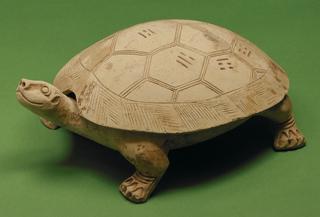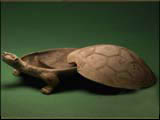
 |
 |
An inkstone is a shallow, CONCAVE receptacle that stands on feet and is covered with a lid. In this case, the supports are the feet of the tortoise, and the shell serves as the lid. The inkstone tortoise is NATURALISTIC but at the same time fanciful. He stands solidly on the ground, ready to serve his purpose, all the while looking up and smiling with curiosity at the writer he serves. Inkstones vary in form and design and usually carry symbolic significance. For the Chinese, the tortoise represented long life, strength, and endurance.
On the shell, the artist incised a pattern of connected HEXAGONS. Eight of the hexagons contain three horizontal lines grouped one above the other, called TRIGRAMS. Each line is either continuous or broken in the middle. These lines can form eight possible trigrams, all of which are represented on the tortoise shell:

The trigrams are combined in pairs to form sixty-four HEXAGRAMS. The meaning of each hexagram is explained in a Chinese book of wisdom called the I Ching, or Book of Change. The symbols of the I Ching are appropriate decoration for an object used by Chinese scholars, who recorded the country's history and philosophy in writing.

Key ideas.
Where does it come from?
What does it look like?
How was it used?
How was it made?
How big is it?
Who Knows?
Additional resources.
